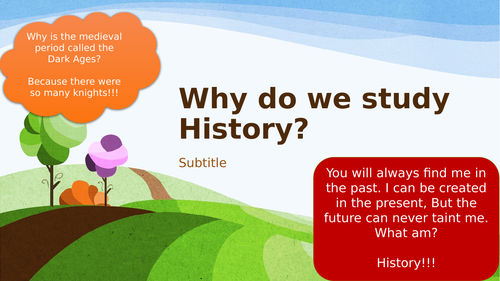

This is the first lesson I use to introduce Year 7 students to History but it could be used with Year 8 and 9. Hopefully, this will give you an idea of what my other resources are like.
The entire lesson, worksheets and handouts are all on one power point to make life easy. The lesson includes:
- A joke and riddle to settle the students while writing down the title and date.
- Clear differentiated SMART learning objectives
- Starter- guess the topics
- Activity 1- History Snowball (post it notes required). Students write down their favorite (or any!) History fact and scrunch it up. They then throw it on the floor and pick up someone else’s fact. They then share their fact with the person next to them and decide which they think is the best fact. I usually pick 3 students to share the fact they liked the most at the end.
- Activity 2- Why studying History is important (video hyper-linked to the photo). Students watch the video and then work with the person next to them to rank the reasons to study History in order of most to least important. There is no right or wrong answer here but builds their skills of creating criteria and making judgments. There are then some questions to discuss at the end.
- Activity 3- after explaining what the historical process is, I ask students to create a poster explaining their favorite event/person/period of history using the example on the slide to give them the success criteria. There are also 2 slides with info for those students not sure of what to do- one on the Tudors and one on World War 2.
- Plenary- In groups of 3 or 4, two students will have a pretend conversation explaining what they have learned in the lesson in silence and the other two have to provide the voice over and explain what they think the other two students having the silent conversation are saying.
- Homework- Create a poster answering the question, “What is History?” Students must choose an event in History and find evidence from that event and also two historians interpretations of that event.
Get this resource as part of a bundle and save up to -67%
A bundle is a package of resources grouped together to teach a particular topic, or a series of lessons, in one place.
Something went wrong, please try again later.
This resource hasn't been reviewed yet
To ensure quality for our reviews, only customers who have downloaded this resource can review it
Report this resourceto let us know if it violates our terms and conditions.
Our customer service team will review your report and will be in touch.
£0.00